ERP Customization vs. Configuration
When implementing ERP software, organizations make many adjustments to tailor the system to their needs. Each “adjustment” exists on a scale that classifies between configuration and customization.
The difference is that a configuration (or personalization) is typically a simpler, out-of-the-box setting change, while customizations are usually more advanced and can require code changes.
The more heavy code customizations a company makes, the more costly and riskier implementation and maintenance becomes. Heavy customizations often extend go-live dates, are poor quality, and break with software updates.
As such, we recommend minimizing heavy ERP customizations; opt for pre-existing, well-maintained integrations when you can. It’s best to find an ERP that fits your business model or adapt your business workflows to fit the ERP instead.
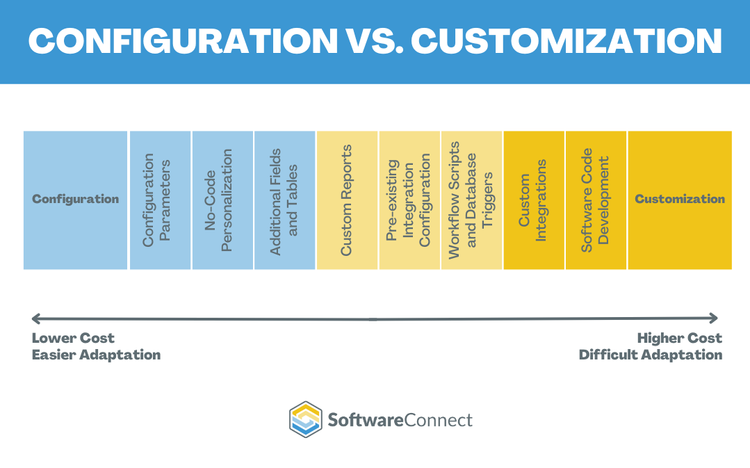
ERP Configuration
Configuration is essential to implementing an ERP system and involves selecting the system’s settings and options.
You can change settings like time zones, languages, currencies, workflows, financial reports, data analytics, and organization-specific business intelligence. Eeach department can have different configurations based on its requirements.
Personalization and workflow automation are two significant components of ERP configuration. Personalization includes reports, analytics, color schemes, and setting employee roles. Workflow automation helps create rules for performing automated functions.
Integrations are another critical aspect of ERP implementation. Some third-party systems are compatible with ERPs and easily integrate with them. However, many are not compatible and require additional customization. Integration also involves importing data, which can be possible with configuration, but customization is often necessary.
Configurations are easier and more cost-effective since they don’t require custom coding.
Pros and Cons
| Pros | Cons |
| Less expensive than customization | All requirements may not be met |
| No source code changes | Most third-party integrations require customization |
| Configurations compatible with ERP software upgrades | Additional modules require customization |
| Client requirements determine configuration once during implementation process | |
| Good for small to medium companies |
ERP Customization
ERP customizations are changes businesses make to their ERP systems to fulfill critical business requirements. These changes usually involve editing the software’s source code to gain functionality the native features don’t include.
Customization allows organizations to add modules and integrations with third-party software that can expand the ERP’s functionality. Customizations also help build industry and company-specific task-management processes and automations.
You can also extend the functionality of existing modules and add steps/ tools to native automation processes.
While some of these changes are possible with configuration, the complexity of the changes depends on the ERP software and your business requirements.
Since customization requires editing the source code, it can be costly and risky. Any time the source code is changed, there is the risk of bugs and breaking the system. Thorough planning, testing, and training are needed to avoid ERP implementation failure.
Additionally, coding can increase the implementation time and add many billable labor hours to your budget. ERP vendors often offer low-code customization, which can help to mitigate the cost and risk increases.
Types of Customizations
Software customizations can take on various forms, changing the formatting, design, and functionalities of the ERP system by modifying its source code. Here are a few of the more common types:
- Design changes: High-level cosmetic changes to the default ERP system.
- Forms and dashboards: Formatting and content changes to frontend forms and backend dashboards.
- Functionality extensions: Modifications to the source code that enhance functionality or introduce new features.
- User interface changes: Cosmetic enhancements to the system based on user preferences.
Pros and Cons
| Pros | Cons |
| Helps meet operational requirements. | Extends budget and implementation timeline |
| Adds modules and functionalities | Needs a dedicated team with ERP, domain, and technical skills. |
| Best for large enterprises | Future changes need additional customization |
| Facilitates integrations with third-party software | Customizations receive little or no support from vendors. |
| Higher risk of exceeding budget and implementation timeline | |
| Needs additional resources and maintenance to operate | |
| No automatic updates to modified software |
Choosing When to Customize or Configure
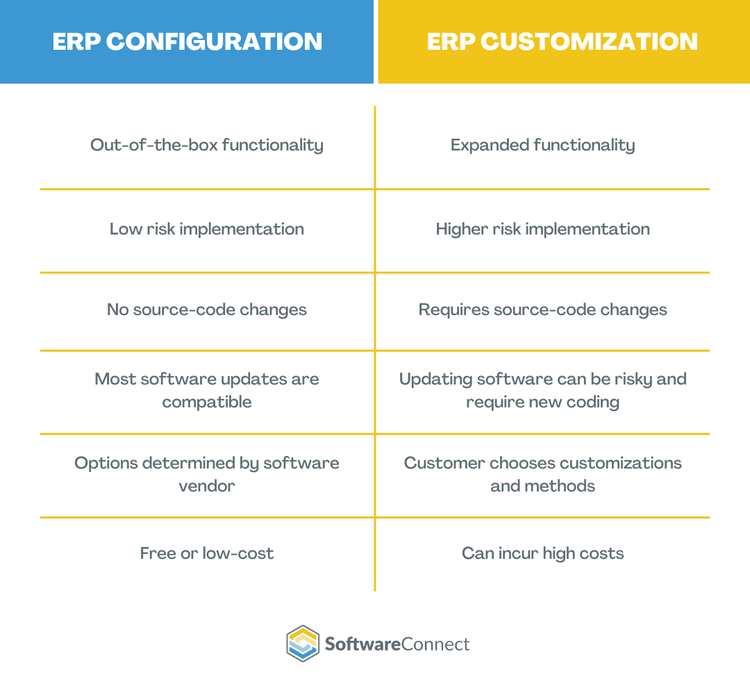
Customization and configuration are not mutually exclusive: Configuration is a mandatory part of implementation, but customization and the level at which it’s done are optional.
As illustrated in the graphic above, customization and configuration are a spectrum. ERP changes are possible through configuration, customization, or both. Also, there are more and less risky and expensive customizations.
For proper implementation of your company’s ERP, it is essential to thoroughly understand your business needs. These business requirements will determine if and how many customizations are necessary or whether configurations alone are sufficient. These requirements will also determine the risks your company should be willing to take when implementing a new system.
Scheduling a demo for your prospective ERP solution helps determine if the out-of-the-box functionality meets your business needs and what customizations may be necessary.
Our Recommendation: Avoid Heavy Customizations
A quick wrap-up of best practices for ERP implementation:
- Minimize heavy customizations that involve changing source code to avoid unnecessary overhead.
- Opt for simpler personalizations and configurations whenever possible.
- Ideally, find an ERP system that aligns with your business model or consider adjusting your business model to fit the capabilities of the ERP.
- It is advisable to avoid excessive code customizing due to numerous implementation horror stories associated with it.
In general, we recommend that you either find an ERP that fits your business model, or adapt your business to fit an ERP. ERPs are often designed around industry best practices, so your business processes may improve by sticking to the ERP’s out-of-the-box features.
While most ERP systems can be customized, it doesn’t necessarily mean you should.
Heavy customizations that involve modifying source code or writing custom components can have all kinds of issues that may result in implementation failure:
- Longer implementation: Customizing an ERP can take significant additional time. Planning, coding, testing, and training can add months or even years to your implementation timeline.
- Higher costs: The risk factors that can result in a longer implementation time (planning, coding, testing, and training) can also affect the implementation cost. Additionally, the more you customize an ERP, the more likely it is to break. These fragile systems require dedicated support staff to constantly monitor and repair them, so this specialized staffing can add to implementation and upkeep budgets.
- More likely to break with core updates: When an ERP is highly customized, updating the core software can be impossible or risky. If the updates are possible, you risk losing the customizations or breaking the software.
- Often leads to poor quality: Unfortunately, many custom features are poorly implemented and can compromise the software’s integrity.
Here are some examples of real ERP users detailing their experiences with ERP customizations:
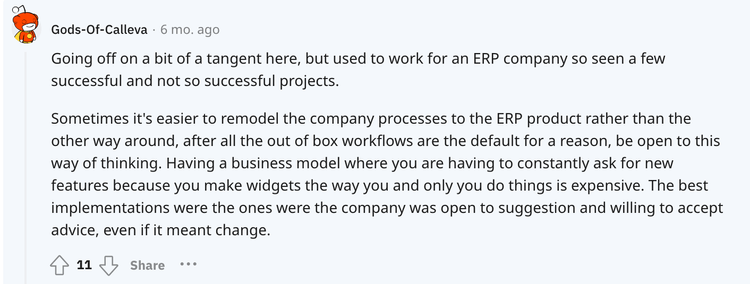
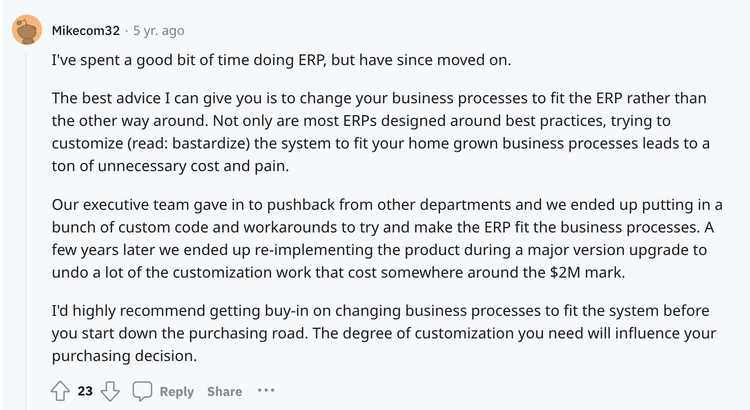
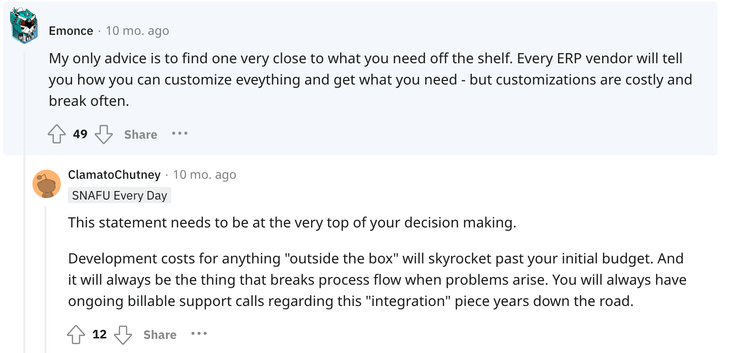
FAQ
When should I customize my ERP system?
Whenever possible, it’s generally better to go with vanilla ERP software and personalize it through configurations. Businesses should only move forward with customization when it creates a competitive advantage or the ERP cannot solve a critical issue with native tools.
What are ERP customizations vs. configurations?
Customizations refer to modifying or adding to an ERP system’s source code to meet organizational requirements. They are different from configurations, which are tweaks to the ERP’s default settings using native tools rather than custom code.
What are ERP integrations vs. configurations?
Configurations refer to optimizing the native tools within an existing ERP system to meet a company’s needs.
Integrations connect a core ERP system to other software solutions through application programming interfaces (APIs). Common modules to connect include customer relationship management (CRM), human resources, and business intelligence (BI tools).
Integrations lie somewhere in between configurations and customizations. Pre-built integrations are closer to configurations, while integrations your company develops in-house are closer to customizations.
